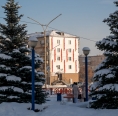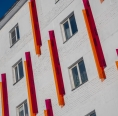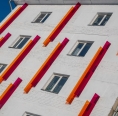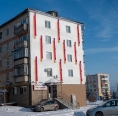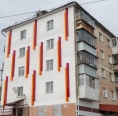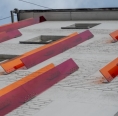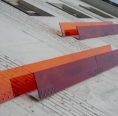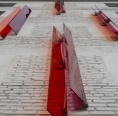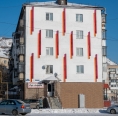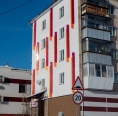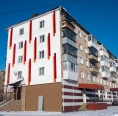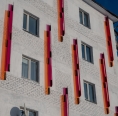-

COMPOSITION NO. 1: REINVENTED CONSTRUCTIVISM
Composition No. 1 is an art installation on the facade of a house on Solnechnaya Street in Satka. It was created by the Moscow artist Vasily Kononov-Gredin. The locals and guests of the city may have seen his Rock Garden Project in the Berezovsky quarry.
The facade of building No. 1 was decorated as part of the transformation of Solnechnaya Street. The rear wall of the building was previously painted white and then bright panels of monolithic polycarbonate appeared against the painted background. Simply put, the composition has double orange and purple stripes casting colored shadows in the sun. Though the design may look very simple, this simplicity has not only its beauty, color, volume and shadow movement but also its inspirational story referring to the avant-garde of the early 20th century. The work is based on the drawings of Kazimir Malevich.
“The idea of the project emerged from the reflections on houses built in the 50s-70s of the last century. Their features include simple forms and proportions based on constructivism. The concepts of functionality and simplicity of this art direction were developed by Kazimir Malevich, Olga Rozanova and many other avant-garde artists,” says Vasily Kononov-Gredin. “This is why it was important for our project not to hide the facade under a bright drawing or make it unrecognizable with a fully new cover. When making the sketches, I was looking for forms that would seamlessly fit into the clear structure of the house as it was intended by its architects”.
In search of an artistic solution, Vasily turned to the drawings of Kazimir Malevich created for the weaving industry.
“His fabrics sketches have apparent simplicity and conciseness, so the basis for the development of our installation was one of the drawings by Malevich. We reinvented and redesigned the drawing. When changing the drawing design, I focused on turning it into a voluminous sculpture and maintaining the clear perception of the form of the original sketch,” explains the creator of the installation.
The reinvented sketch covers not only new meanings but also image development. The artist points out that one of the main features of this piece is how it interacts with the environment.
“Sun, clouds or fog will create a live imprint of the piece on the building. The material of our choice is monolithic polycarbonate of bright shades that harmoniously match each other: magenta or bright purplish pink and saturated orange. They go well together and these are the colors we often lack during a long winter. 20 panels of 4 meters by 20 centimeters are attached to the wall with special stainless steel stops at an angle of 50 degrees to make the installation visible from different sides when moving along the street. It is clearly visible both when we look at the object directly and when we go or drive up or down the street. And the light that penetrates through the transparent material creates colored shadows in the installation; depending on the time of day and lighting, they lay on the white surface of the house differently. This creates a living picture. Colored shadows become a natural continuation of the idea of painting,” believes Vasily. He also reminds the viewers that this live game with light and nature sends us back to childhood, to catching sunbeams in a mirror and looking at the world through colored glasses.
“It’s the opposite of stained glass. It becomes visible not from the inside of the room but the outside,” adds the artist. “It’ll be interesting not only during a sunny day but also with clouds when soft colored shadows will appear. It’s a breathing, changing, delighting object.”
The author named his project “Composition No. 1”, which is also a reference to the numbering of works used by avant-garde artists of the 20th century. They often gave their paintings the same name but different numbers. For example, Kazimir Malevich had Supremus No. 56 and Supremus No. 58 while Vasily Kandinsky created Improvisation 20 and Improvisation 33.
Speaking about his return to Satka with the new project, Vasily says that it was a desirable act for him.
“I liked Satka, people and their attitude to the city and art,” he said. “The way you decorate your city, the way art is integrated into the urban environment and changes it towards harmony and beauty sets an example for most Russian cities. Returning to Satka is a significant event for me. This is a city that I don’t just love but I’m proud of it because the Rock Garden – my mirror installation in the quarry – was not only my first big project. It became a major project on a country scale. It’s an unforgettable experience! The attention, interest and respect for the work and everything that I experienced here in general and that is now connecting me to Satka – these are the deepest and most positive impressions. I work in many other cities but Satka will remain the point where I started, the point where I continue and, hopefully, will continue to create.”
It should be added that the decorating works on the lower part of the facade are planned to be completed next week. The project is implemented by the Satka District Development Assistance Fund with the support of the Satka District Administration and the Magnezit Group.
---
The transformation of Solnechnaya Street is a part of the framework of projects for public areas improvement with the support of the Satka District Development Assistance Fund. To date, the fences along the pedestrian zones have been dismantled on the street to create more space, the border stones have been replaced and 300 spirea bushes have been planted. The repairs of the stairway, ramp and part of the sidewalk near building No. 26 have been completed. The passes near building No. 15, the Magnezit Cultural Center and the Stroitel Cultural Center have been rearranged. The ground for flower beds has been prepared so the separating strip between the carriageways will be brightened up with golden poppies in the next year. This is only a small part of the grand plans within the framework of the Blossoming City Program. The locations for planting conifers and fruit trees have been selected: pines, apples and pears will be planted along the roads in April 2023.
Source: Magnezitovets. Photo by Vasily Maksimov.
-
26.08 - 26.08
DIARY OF THE THIRD INDUSTRIAL BIENNALE
-
28.11 - 28.11
MY SATKA FESTIVAL WINS THE CONTEST OF CORPORATE VOLUNTEER PROJECTS
-
13.10 - 15.10
COOPERATION WITH VGIBL NAMED AFTER M.I. RUDOMINO

